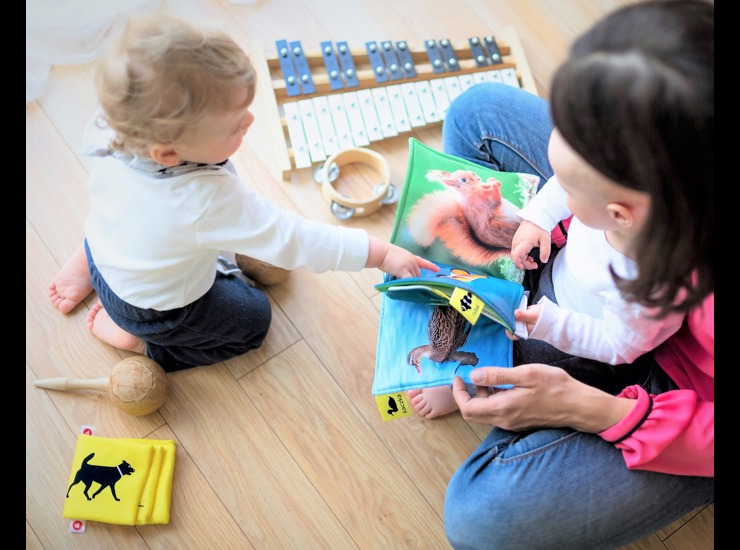
Us parents are bombarded with all sorts of information. Do this. Do that. Whatever you do, don’t do THAT! The problem is, lots of the advice we receive isn’t based on any solid evidence – it’s just passed on by word of mouth or even made up on the spot by the person writing the article. This is a real shame because, at least when it comes to children’s language, we do have quite a bit of evidence on what works and what doesn’t. So ditch the well-meaning flimflam and have a look at my evidence-based tips for boosting your child’s language development.
Talk to your child before they’re born!
Yes, I know it sounds weird. But they can hear you in there, and they’re picking up not only the distinctive sound of your voice but even the general melodies and rhythms of the language they’re learning: A study conducted in New York found that babies just two days old already preferred to listen to either English or Spanish, depending on which their parents spoke. So, get chatting: It doesn’t matter what you say – the sound is far too muffled for them to learn individual words anyway – the important thing is just to talk.
Speak “Parentese”
“Whoooooos a GOOD little Mummy or Daddy then? YEEEESSSSS that’s RIIIIIIIIIIGHT. You AAAARE!” Sorry about that, I just lapsed into “Parentese” – That distinctive way of talking to babies and young children, where you hype everything up, stretch out the words and emphasise the highs and the lows. Yes, yes, I know we all feel a bit self-conscious doing it, but it’s worth it: This study found that Parentese improved children’s language at 18 months (and, no, this isn’t one of those correlation-isn’t-causation studies – it was a proper intervention study with a control group and everything!).
Point
Babies who point more learn language faster. And the more you point, the more your baby will point. But not all pointing is equal. Pointing at something because you want it (“get me that!”) is good; but pointing at something because you think the other person will find it interesting (“hey, wow, look – that thing is cool!) is better; it’s the start of real communication. So, as well as demonstrating this kind of pointing yourself, try to set up scenarios that will encourage your child to do likewise. For example, you could ask a family member to wave a colourful puppet on the other side of the room – but in the eyeline of your child – and pretend not to notice it. With any luck, she’ll point!
When your baby babbles, talk back.
Before your baby says any recognizable words, she’ll babble: ba-ba-ba, da-da-da, ga-ga-ga and the like. Researchers used to think babble was just a bit of fun, but it’s actually very important – babies use babble to practice the sounds of the language they’ll soon be speaking. So, the more your baby babbles the better. And you can get her to babble more by talking back. It doesn’t matter much what you say, although some evidence suggests that repeating their babble back as real words might be especially helpful (e.g., if she says da-da-da, say “Yes, Daddy’s here isn’t he?!”).
Follow, don’t lead.
Say there are some blocks and a teddy on the floor, and your child is looking at the blocks. Should you talk about the blocks (following in on their attention) or the teddy (leading their attention to something new)? Some people find it counterintuitive, but the answer is that following is better for children’s language development. Even better, don’t just describe (“Yes, that’s a red block”), but ask them to do something with the object they’re interested in (“Yes, that’s a red block, isn’t it? Can you pick it up?”).
Read. But don’t JUST read.
Some parents think that the best way to read a book with their child is to get from the start to the finish as quickly as possible with no interruptions (like one of those impatient bus drivers who seems determined not to let anybody on or off). This is exactly wrong. Your goal instead should be to use the book to get your child talking – for her to take on the role of storyteller. Prompt your child to tell you what’s happening (What’s that up in the sky?). Evaluate her response (A tree? Actually I think it’s a plane). Expand on it (And there’s also the sun up there in the sky, isn’t there?) and Repeat the prompt (So what was that up in the sky again?). Some people use the mnemonic PEER to remember these steps, but they’re not crucial. The important thing is just to get your child talking. The same goes for CROWD, which some people use to remember the different kinds of prompts you can use: Completion (The sun is up there in the…), Recall (Can you remember what was in the sky?), Open-ended(What’s happening on this page?), Wh-question(What/where/who/how/why’s that?), and Distancing questions (What did YOU see when you went to the beach?). I know dashing through the book is tempting, particularly when you’re desperate to get the kids to bed, but a meta analysis of 16 studies found that this type of reading was much better than business-as-usual reading, particularly with 2-3 year olds.
Correct them, but invisibly
As your child becomes more chatty, you’ll notice her making some common “mistakes”, saying things like I goed to the shops or Her need some juice. Your job here is to repeat what she said, fixing the mistake, and maybe expanding a bit. But ever so subtly. Don’t mention the mistake, and (like in improv theatre) say “Yes” not “No”. For example, if you child says I goed to the shops you could say Yes, you went to the shops with Granny didn’t you? If she says Her need some juice, you could say Yes, she needs some juice doesn’t she? She looks thirsty! Again, I’m not just making stuff up here, this recommendation comes from a meta-analysis of 14 high quality experimental studies all of which included control groups.
Go beyond the here-and-now
By age 3, most children are pretty good talkers, at least when they’re talking about what’s in front of them. The next step is to get them talking about things that go beyond there here-and now. And doing this when you’re talking to them boosts children’s vocabulary. This needn’t be complicated: Just use the mnemonic PEN to remember the three types of beyond-the-here-and-now talk: Pretend: This one’s easy – from using a banana as a phone, pretending a chair can talk, acting out shopper-and-shopkeeper scenarios…you get the picture. Explanations: “It’s not working because the batteries have run out and we need to put new ones in”. Narratives: This involves talking about things that have already happened (“Remember yesterday you went to the shops with Granny, didn’t you?”) or are going to happen (“So tomorrow’s the weekend, and your cousin is going to be coming round”).
…But not all the time!
I get it – parenting is hard work. Sometimes you just need to park your kid in front of The Baby Club, Peppa Pig or Paw Patrol for a couple of minutes just so you can have a wee on your own. And now you have to be a full-time language teacher as well?! Relax – you don’t! If you are able to set aside some time for pretend play or reading a book – great! But we’re talking minutes not hours here. And you certainly don’t need to set aside some “Pointing time”, “Correction time” or “Beyond-the-here-and-now talk” time – just try to build these things into whatever it is you’re doing anyway (“I’m going to make a cup of tea now – Look [point] – there’s the kettle” etc.). And if the details of what I’ve said are complicated or overwhelming, forget about them – the important thing is just to talk, talk, talk!

